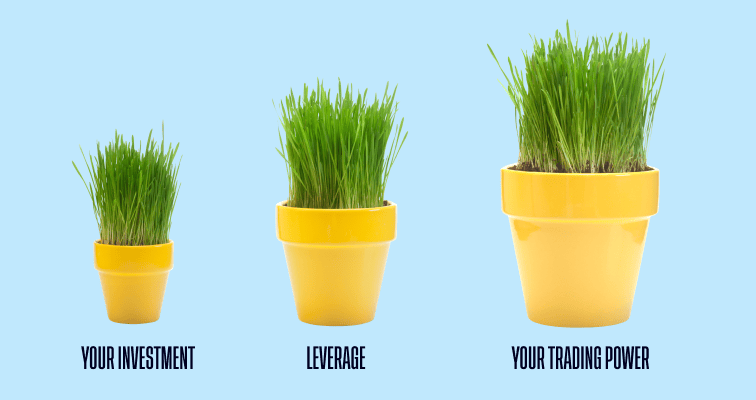Consider some leverage and margin trading strategies that investors can implement when trading crypto CFDs. Explore the potential advantages and disadvantages of trading crypto using leverage and learn how to manage risk and mitigate losses.
Leverage and margin trading is a risky strategy employed by experienced investors across all markets, but how can it be applied to cryptocurrency trading?
How to leverage and margin trade crypto
Leverage and margin trading of crypto involves investors using their own capital as

Using leverage to trade crypto typically involves using a Contract for Difference (CFD), which is different to simply buying cryptoassets outright. Trading crypto using CFDs enables users to open a position without owning the underlying asset.
Trading crypto CFDs with leverage can present crypto investors with opportunities to mirror the unique and
Please note that CFD crypto is restricted for UK users.
Tip: Leverage and margin trading crypto will increase an investor’s exposure to volatile market conditions, for better or worse.
Leverage and margin trading strategies
There are various types of crypto trading strategies which utilise leverage and margin. Choosing which one to adopt will be influenced by your personal circumstances, trading experience, and investment aims.
Long and short crypto positions
Users can leverage their positions by either opening a
Leverage ratios in crypto
The proportion of margin to leverage in a position will typically be depicted as a ratio (for example, 1:10, 1:20, 1:30). Crypto traders can select the amount of leverage they wish to borrow depending on their tolerance to risk and the margin (or “collateral”) they wish to provide.
Crypto Margin management
Crypto traders can also manage their margins while a position is open with a considered reaction to a
In case of liquidation, investors can also prepare their portfolio by selecting either an “isolated” or “cross margin” approach.
- Isolated margin relates to the collateral for a single position, for which a loss will not impact an investor’s wider portfolio or any other positions in it.
- Cross margin relates to margin shared across multiple positions, whereby a margin deficiency in any one position will be covered by the returns from any other position.

Leverage and margin: risk management
Users need to be aware that trading CFDs with leverage and margin will extrapolate losses, as well as returns. It is for this reason that investors considering margin trading should do so as a part of a well-thought-out crypto investment strategy.
Although the prospect of using leverage may seem daunting, there are plenty of strategies to help crypto investors maintain a well-balanced
- Use a
stop-loss to close a position at a predetermined point in the event that the market moves in an unfavourable direction. - Trade management can also involve using take profit instructions to lock in gains once a position has reached a predetermined level of return. Alternatively, set a series of incremental orders to take profit gradually, rather than attempting to time the market with a single
exit point . - Practise margin trading with a demo account (“paper trading”) to build experience without risking real capital.
- Gradually increase the size of the leverage by starting with small positions and building them over time.
- Limit the time period of open trades to mitigate the risk of sharp, unforeseen price drops or long-term market corrections.

Advantages and disadvantages
Like any investment strategy, trading cryptocurrency CFDs with leverage has both advantages and disadvantages. In this case, the positives and negatives tend to mirror each other.
For example, while margin trading offers the potential for greater returns, it also presents the risk of greater losses in the event of an unsuccessful trade.
- Exposure to a position without having to own the underlying asset
- Greater potential returns
- Strategy diversification
- Trade with limited capital
- Teaches risk management and investing discipline
- Do not own the underlying asset
- Greater potential losses
- High-risk trading
- Can lose capital quickly in volatile markets
- May be difficult for new traders
Final thoughts
Using leverage and margin to trade crypto CFDs can be daunting for new investors, due to the higher level of risk attached to the strategy itself, and the volatile nature of the crypto market.
For new investors, or those unfamiliar with using leverage, it is sensible to get to grips with the fundamentals of the practice before risking any capital.
Visit the eToro Academy to learn more about trading with leverage.
FAQs
- Which cryptocurrencies are most commonly traded with leverage?
-
Large cap cryptocurrencies are typically the most commonly traded using leverage. Although the market remains volatile, these are considered to be lower risk than other cryptoassets with a smaller market cap. Some investors with a higher risk tolerance will trade small cap cryptocurrencies with leverage, but these tend to be more volatile and so the opportunity to lose money is amplified.
- Can I lose more than my initial investment?
-
It is possible to lose more than your initial investment when trading crypto and leverage magnifies not only potential returns, but also potential losses. If your account is safeguarded by negative balance protection protocols then when margin runs low because of a losing trade, your broker will issue a margin call, requiring an additional deposit or force you to close your position. But not all accounts apply NBP so you can lose more than you initially invested.
- What is liquidation in leverage trading?
-
Liquidation in leverage trading is the process by which your leveraged position is automatically closed by your broker or exchange in order to prevent further losses. This usually occurs in the event of a losing trade where the value of your position falls enough to threaten the margin requirements.
This information is for educational purposes only and should not be taken as investment advice, personal recommendation, or an offer of, or solicitation to, buy or sell any financial instruments.
This material has been prepared without regard to any particular investment objectives or financial situation and has not been prepared in accordance with the legal and regulatory requirements to promote independent research. Not all of the financial instruments and services referred to are offered by eToro and any references to past performance of a financial instrument, index, or a packaged investment product are not, and should not be taken as, a reliable indicator of future results.
eToro makes no representation and assumes no liability as to the accuracy or completeness of the content of this guide. Make sure you understand the risks involved in trading before committing any capital. Never risk more than you are prepared to lose.


